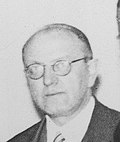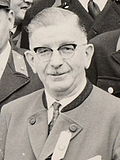After 1918: Republic
| No. | Portrait | Name | Term | Party | Period | ||
|---|---|---|---|---|---|---|---|
| Took office | Left office | Duration | |||||
| 1 | Leopold Steiner | 5 November 1918 | 20 May 1919 | Christian Social |  First Republic (1918–1934) | ||
| 2 | Albert Sever | 20 May 1919 | 10 November 1920 | Social Democrat | |||
| 3 | Johann Mayer | 10 November 1920 | 9 June 1922 | Christian Social | |||
| 4 |  | Karl Buresch | 9 June 1922 | 31 July 1931 | Christian Social | ||
| 5 | Josef Reither | 31 July 1931 | 19 May 1932 | Christian Social | |||
| (4) |  | Karl Buresch | 19 May 1932 | 18 May 1933 | Christian Social | ||
| (5) | Josef Reither | 18 May 1933 | 30 July 1934 | Christian Social Fatherland's Front | |||
| 6 | Eduard Baar-Baarenfels | 30 July 1934 | 17 October 1935 | Fatherland's Front |  Austrofascism (1934–1938) | ||
| (5) | Josef Reither | 17 October 1935 | 12 March 1938 | Fatherland's Front | |||
| (Reichsstatthalter and Gauleiter of the Reichsgau of Lower Danube) | Nazi Germany (1938–1945) | ||||||
| 7 | Roman Jäger | 12 March 1938 | 24 May 1938 | NSDAP | |||
| 8 |  | Hugo Jury | 24 May 1938 | 8 May 1945 | NSDAP | ||
| 9 |  | Leopold Figl | 25 May 1945 | 15 October 1945 | ÖVP |  Second Republic (1945–present) | |
| (5) | Josef Reither | 15 October 1945 | 4 May 1949 | ÖVP | |||
| 10 | Johann Steinböck | 4 May 1949 | 14 January 1962 | ÖVP | |||
| (9) |  | Leopold Figl | 14 January 1962 | 9 May 1965 | ÖVP | ||
| 11 | Eduard Hartmann | 16 June 1965 | 14 October 1966 | ÖVP | |||
| 12 |  | Andreas Maurer | 24 November 1966 | 22 January 1981 | ÖVP | ||
| 13 |  | Siegfried Ludwig | 22 January 1981 | 20 October 1992 | ÖVP | ||
| 14 |  | Erwin Pröll | 20 October 1992 | 19 April 2017 | ÖVP | ||
| 15 |  | Johanna Mikl-Leitner | 19 April 2017 | Incumbent | ÖVP | ||